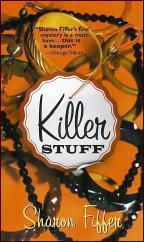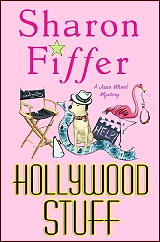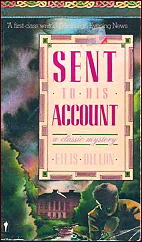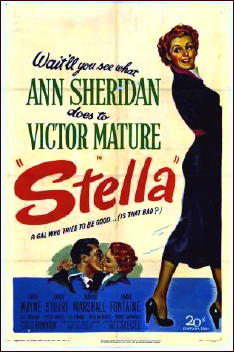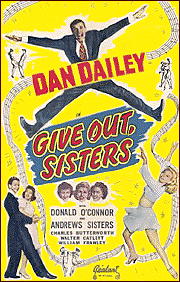February 2010
Monthly Archive
Mon 22 Feb 2010
REVIEWED BY TINA KARELSON:
SHARON FIFFER – Buried Stuff.
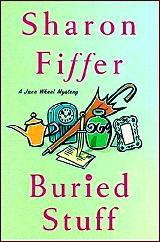
St. Martin’s Minotaur, hardcover, October 2004. Reprint paperback: St. Martin’s, November 2005.
Fourth in the series featuring Jane Wheel, antiques “picker” and ex-adwoman. This time, Jane is back in Kankakee with her geologist husband and son.
Bones have been found on the farm of a longtime customer of Jane’s parents at the EZ Way Inn. The family is helping to identify the bones so the farmer can get government clearance to sell topsoil.
The portrayal of family dynamics is the strongest element of this series, and Buried Stuff delivers that in spades. The decline of Kankakee and the schemes afoot to revive it are also astutely and evocatively described.
In the final analysis, this small, bittersweet story about a shooting delivers an authentic emotional punch, but it’s not a clever or suspenseful mystery.
The Jane Wheel Series —
1. Killer Stuff (2001)
2. Dead Guy’s Stuff (2002)
3. The Wrong Stuff (2003)
4. Buried Stuff (2004)
5. Hollywood Stuff (2006)
6. Scary Stuff (2009)
Mon 22 Feb 2010
THE BACKWARD REVIEWER
William F. Deeck
EILÍS DILLON – Death at Crane’s Court. Walker, US, hardcover, 1963. Paperback reprint: Perennial, 1988. Trade paperback: Rue Morgue Press, 2009 (shown). First UK edition: Faber & Faber, 1953.
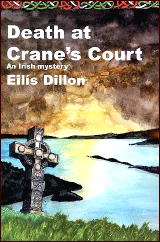
To his dismay, George Arrow, of no particular occupation but with a comfortable income, is told by a doctor he consults after he passes out one day that he has a bad heart condition and must avoid most activities and any excitement. A good place to go that meets those exigencies is Crane’s Court, a posh hotel in Galway, Ireland.
Unfortunately, Arrow discovers that Crane’s Court is actually a hotbed of intrigue. A new owner has inherited the hotel and intends to put the old residents — old in both age and tenure — in their place or cast them out.
Of course, the old people are up in arms, or at least those who can lift them are. Is it possible they en masse, or one of them a little more agile than the others, plunged a chef’s knife into the new owner? Or maybe it was the dotty old lady who has numerous cats that tend to die before their time and who gets visited by the haunt who built the original Crane’s Court.
Referring to the elderly inhabitants, Professor Daly says:
“The old are sometimes very terrifying. . . . I know why, because I’m old myself. It’s a return to the direct simplicity of childhood, but now they are free from childhood’s discipline. They stare unrestricted. and gobble their food, and ask personal questions, and they make loud personal remarks.”
Heresy is about to he committed by this reviewer, and no doubt there shall be moves to have me expunged from the ranks of true mystery fans. Nonetheless, I have to state that this is a fine novel until the murder. When Inspector Mike Kenny arrives to investigate the killing, Arrow and Daly begin to take a back seat and the book then becomes only very good.
– From The MYSTERY FANcier, Vol. 13, No. 3, Summer 1992.
Bibliographic Data: [Taken from the Revised Crime Fiction IV, by Allen J. Hubin.]
DILLON, EILÍS. 1920-1994.
Death at Crane’s Court (n.) Faber 1953. [Insp. Mike Kenny]
Sent to His Account (n.) Faber 1954.
Death in the Quadrangle (n.) Faber 1956. [Insp. Mike Kenny]
Why only the three detective novels, in a long career of writing? (She “…was the author of fifty books, ranging from children’s stories to historical novels. She wrote and translated poetry, and had two plays produced by the Abbey Theatre company.”)
There’s a long account of her life by her son, Cormac Ó Cuilleanáin, at the Rue Morgue Press website, from which the previous excerpt was taken, along with the answer. As a short biography of her, it’s well worth reading.
The other good news is that all three mysteries have been reprinted by Rue Morgue Press.
Sun 21 Feb 2010
COLIN ROBERTSON – A Lonely Place to Die.
Robert Hale, UK, hardcover, 1969. No US edition.
You can sometimes buy the darnedest things on eBay, which is what happened not too long ago, when I picked up a small collection (seven) of Colin Robertson’s hardcover mysteries from a seller in Canada.
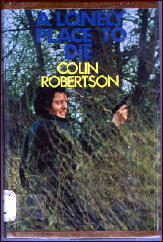
And even though seven sounds like a sizable amount, it is indeed small when you compare it to the author’s total output, which runs to something like 57 novels and collections under his own name, not including a Sexton Blake adventure that came out under the house name of Desmond Reid.
The book I happened to pick, more or less at random out of the stack, is an adventure of Peter Gayleigh, a name I confess I did not know ahead of time, and whom I will get back to in a minute.
First, though, here’s a list of all of the series characters that originated from the typewriter of Mr. Robertson. See how many of these fellows (and one gal, I believe) you recognize. In chronological order of their first appearances:
Inspector John Martin (1935-39; three books.)
Inspector Robert Strong (1935-40; four books)
Victor Raiefield (1938-40; two books, both in tandem with Strong)
Peter Gayleigh (1939-69; fifteen books)
Edward North (1950-53; four books)
Vicky McBain (1951-61; nine books)
Supt. Bradley (1957-70; eleven books)
Alan Steel (1965-68; three books)
There were some stand-alone’s as well, in case you were trying to make the total come out right. And to tell you the truth, as I hinted at above, I am only assuming that Vicky McBain is female. Googling did not help. I found only one semi-useful reference, and it did not say either way, only that Vicky was a private investigator. And if you were wondering, no, none of the other six Robertson’s I obtained via eBay are Vicky McBain thrillers either, so there’s no assistance to be gained from that quarter.
But a few of the ones I have are affairs that it was up to James Bond knockoff Alan Steel to handle. I use the term “knockoff” deliberately and in similar fashion to Peter Gayleigh, who seems to have followed in the footsteps of one Simon Templar, gentleman adventurer, rather closely.
Or perhaps, if one to were to analyze the matter a bit more closely, it might be possible to conclude that John Creasey’s Richard Rollinson (aka The Toff) was also a model. At one point while reading A Lonely Place to Die, that’s who I was definitely reminded of, according to the note to myself I wrote at the time.
In fact, what I’ll do is give you the paragraph I was reading when I made myself that comment, and you can judge for yourself. From page 62:
As Diana [Caryll, Gayleigh’s close lady companion] had found, he [Gayleigh] affected the privileged few who worked for him in that way. There was something in his vital personality that bound his subordinates to him with enduring loyalties. It was partly the buccaneering recklessness in those cool blue eyes; partly his inherent capacity for overcoming any obstacle; but in the main that indefinable attribute of the born leader.
Or maybe not. Note the use of the word “buccaneering.” On page 70, Gayleigh is again referred to as “a notorious character, an insolent buccaneer,” so maybe the Simon Templar comparison is not so far off, since that is exactly how I remember The Saint being described in Mr. Charteris’s books. You decide.
I had no idea while I was reading this book that it was to be Gayleigh’s last (recorded) adventure, a spy caper involving a deadly virus designed for germ warfare, although I doubt that knowing it would have changed my opinion of it very much, if at all.
He and Diana (see above) live apart, and they seem to have a rather chaste relationship, for all of the companionship there exists between them.
What is rather remarkable – or let’s make that “who” – is a femme fatale who nearly comes between them. At the least, there are strong hints (see page 89) that Gayleigh is strongly attracted to Corinne Raeburn, a madcap heiress or jet-set socialite not akin to an early Paris Hilton, but one with a gun. And she is also a woman who knows how to use it.
Unfortunately the plot itself is strictly a paint-by-numbers sort of affair, brightly colored in spots and not making a lot of sense in others. While the book kept me reading for the requisite amount of time, I see the other six books sitting there, and I say to myself about Colin Robertson, probably not next. Sometime soon, perhaps, but not next.
— January 2006
[UPDATE] 02-21-10. Nor not yet, I’m sorry to say. I don’t remember this book all that well — that’s one of the reasons I starting writing reviews, way back when, so that I could remind myself of what I thought of a book, long after I’d have otherwise forgotten it — but for some reason, I remember enjoying it more than that last paragraph would indicate.
Nor, in the meantime, do I seem to have learned anything more about Vicky McBain. At the moment I have the feeling, however, since the name is spelled Vicky, not Vickie, that “she” is a he. Someone who knows will probably tell us soon.
[UPDATE] 02-23-10. And here’s the answer, which I’ve just received via email from British mystery bookseller Jamie Sturgeon:
Hi Steve,
Vicky McBain, as you surmised, is a male. From the blurb to Who Rides a Tiger —
Colin Robertson’s famous private detective, sets out to clear his friend, Greg Rillston of murder … McBain, hard-hitting, hard-headed, but very human, is a character that stands out from the pages of thriller fiction.
The book is narrated in the first person so I can’t give you a physical description of him but he is 38 years old, he has an office in central London with a secretary called Kay and his car is a vintage coupe.
Sat 20 Feb 2010
A TV Review by MIKE TOONEY:
“One Tiger to a Hill.” An episode of Kraft Suspense Theatre (Season 2, Episode 8). First air date: 3 December 1964. Barry Nelson, James Gregory, Diane McBain, Peter Brown, Warren Stevens. Writer: Robert Hamner. Story consultant: Anthony Boucher. Director: Jack Arnold.
When $400,000 worth of valuable jewels are stolen, Lieutenant Wade (James Gregory) is certain who did it, his constant adversary cat burglar Colin Neal (Barry Nelson). But at the same time the theft occurs, Wade is enjoying some fine wine with Neal and his girlfriend Diana (Diane McBain) in a swanky restaurant, giving Neal an ironclad alibi.
Lieutenant Wade knows Neal must be behind this somehow; what he doesn’t know is that Neal, well aware of the close police scrutiny he is under, has been training an apprentice, Chris (Peter Brown), to steal for him.
But what even Neal doesn’t know is that his girlfriend has been seeing Chris on the side — and that Chris has plans for the loot that don’t include Neal. When Neal does become aware of these developments, however, he is moved to take action. How does the old saying go? You must set a thief …
… To Catch a Thief, Hitchcock’s 1955 thriller, was undoubtedly the inspiration for this one. (And any instances of ingenuity you may detect in the storyline are most probably due to story editor Anthony Boucher, who excelled at this sort of thing.) The police lieutenant and the master thief are the best of enemies, each one having grudging respect for the other.
Barry Nelson’s criminous credits include Eyes in the Night (1942), Casino Royale (1954, as the very first screen James Bond), The Borgia Stick (1967), and appearances on Nero Wolfe (1981) and Murder, She Wrote (1988).
James Gregory appeared in nearly 200 TV shows and movies, including Naked City (1948), The Lawless Years TV series (1959-60), The Manchurian Candidate (1962), the lousy Dean Martin “Matt Helm” film series (1966-67), Columbo (1972), Police Story (1974-75), Detective School (1979), and a long run on the Barney Miller series (1975-82).
Unlike Nelson and Gregory, Peter Brown is still with us. His longest-running involvement with TV has been in Western series: as a deputy marshal on the serious Lawman (1958-62) and the humorous Laredo (1965-67).
Sat 20 Feb 2010
A MOVIE REVIEW BY DAVID L. VINEYARD:
THE EAGLE AND THE HAWK. Paramount Pictures, 1950. John Payne, Rhonda Fleming, Dennis O’Keefe, Eduardo Noriega, Thomas Gomez, Fred Clark, Frank Faylen, Grandon Rhodes, Walter Reed. Screenplay: Geoffrey Homes & Lewis R. Foster, based on a story by Jeff Arnold. Director: Lewis R. Foster.
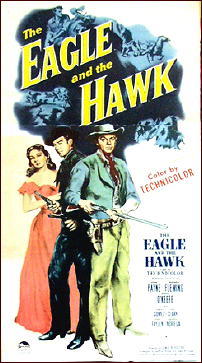
“I see a army building in the mountains, I see peasants with silver in their pockets for joining that army, and I hear El Captain speak of leading an army into Tejas when word and arms come from Presidente Juarez.”
The time is 1863, in the midst of the Civil War, and Texas Ranger Todd Croydon (John Payne) is more than a little curious when the man he rescues from the Confederate army at the request of Governor Lubbock (Grandon Rhodes) of Texas proves to be Yankee spy Whitney Randolph (Dennis O’Keefe).
The governor hasn’t turned traitor. O’Keefe is spying on Mexico not Texas. Someone is building an army on the border and O’Keefe has evidence it is part of plot by Napoleon III of France to seize Mexico and wrest it from President Benito Juarez’s fledgling democracy.
Croydon agrees to escort Randolph to Mexico, and once they arrive they learn the plot is more dire than they suspected. Basil Danzeeger (Fred Clark), claiming to be an agent of Juarez, has convinced the charismatic El Captain, the Hawk (Thomas Gomez) to raise and army to invade Texas, vulnerable as the Civil War rages.
What El Captain doesn’t know and must be convinced of is that Danzeeger is really an agent of Napoleon III and Maximillian, so Croydon agrees to spy on Danzeeger while Randolph infiltrates El Captain’s troops.
“This spying business … wouldn’t be dangerous would it?”
“Little bit. Worse that can happen to you is you get killed.”
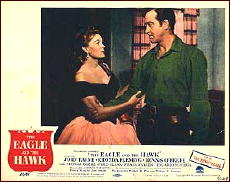
And to complicate things Croydon finds himself falling for Clark’s beautiful wife Madeline (Rhonda Fleming) a French agent who has been smuggling arms into Mexico, and Danzeeger’s right hand man Red Hyatt (Frank Faylen) thinks he remembers Croydon’s face — as he should since Croydon once shot him during a bank robbery.
“So, what’s your name?”
“Todd.”
“Todd what?”
“Just Todd, my mother was close mouthed.”
Lewis R. Foster and John Payne teamed for several good tough films in this era including El Paso, Crosswinds, and Captain China, and this tough little A western is a good example.
The script, co-written by mystery writer Geoffrey Homes (Daniel Mainwaring) is smart and tough with a dash of international intrigue added to the usual western mix, and Payne and O’Keefe make a good team, the taciturn man of action and the glib fast talking but equally brave secret agent. A running gag about O’Keefe’s uncanny luck at cards and dice and losing his boots actually ties into the plot.
Payne and O’Keefe teamed in at least one other western from the same era, Passage West (1951). Foster is best remembered for writing the original story for Frank Capra’s classic Mr. Smith Goes To Washington, for which he won an Oscar.
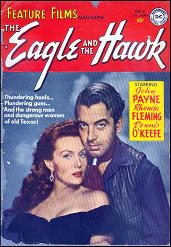
The highlights of the film occur when the captured Payne is tied between two wild mustangs, a la Byron’s Mazeppa, to be torn apart as they run wild, and the fiery confrontation on a burning mountain between Danzeeger, Croydon, and El Captain in the finale. James Wong Howe’s legendary touch as the cinematographer is another bonus.
You can download the comic book adaptation of this here under Movie Westerns for free along with a free CBR (comic book reader).
A minor A western with a solid cast and better than usual screenplay, The Eagle and the Hawk will hold your attention, and remind you how many of these solid entertainments Hollywood used to turn out seemingly without effort.
Payne is tough and romantic, O’Keefe cool and slick, Fleming beautiful and passionate, Gomez dangerous but noble, Clark and Faylen treacherous and sadistic — a fairly stock cast, but done with intelligence by sure hands it all adds up to an entertaining oater with a touch of something more, and a tough literate screenplay adds to the film’s bonuses, as does James Wong Howe’s cinematography.
Fri 19 Feb 2010
STELLA. 20th Century-Fox, 1950. Ann Sheridan, Victor Mature, Leif Erickson, David Wayne, Randy Stuart, Marion Marshall, Frank Fontaine, Evelyn Varden. Based on the novel Family Skeleton (Doubleday Crime Club, 1949) by Doris Miles Disney. Screenwriter & director: Claude Binyon.
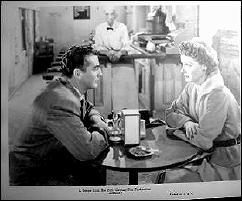
If there is a noir film that’s also an out-and-out comedy, not a black comedy, this one might be it. Or at least it would if it had more than the 20% noirish elements to it than I’d gauge that this one has.
Stella, as played by Ann Sheridan, is the center of the film, and if my 20% figure is right, she accounts for 95% of it. She’s Stella Bevans, in this one, the hard-working secretary of a real estate and insurance agent in an unnamed seashore community. By default, or so it seems, she’s also the “all but” fiancée of her boss, a rather uninspired if not inept fellow by the name of Fred Anderson Jr. (Leif Erickson).
Stella is also the main means of support for the rest of her family, her mother, two sisters, and the respective husbands of the latter (David Wayne and Frank Fontaine), two gentlemen who work only during the summer season, then spend the other nine months on unemployment insurance.
So Stella’s world-weary and disillusioned, and prone to fighting off her boss as he chases her around her desk after hours. Literally. Entering at precisely that moment is Jeff DeMarco (Victor Mature), an investigator from the home office, who’s been assigned to check up on Fred.
The new man in town is attracted, she’s not and she makes no bones about resisting his advances. All of which has nothing to do with the story, which really is about Uncle Joe, Stella’s mother’s no-good brother-in-law, who was killed in an accident, but fearing they wouldn’t be believed, Stella’s family, unbeknownst to her, buries him and claims he’s off on another of his binges.
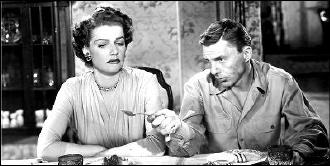
And no matter how she turns, Stella finds herself getting deeper and deeper into supporting their story, the passing of time making it more and more difficult to tell the truth.
Where does the humor come in? As more and more dead bodies are found, Stella’s two brothers-in-law keep claiming them to be Uncle Joe, who as it also turns out, had a $10,000 life insurance policy, with double indemnity kicking in in case of accidental death.
I laughed out loud at least a couple of times, alone in a room by myself, and that almost never happens.
But stuck with Fred, unable to act on her growing attraction to Jeff, and fed up with the antics of her family, Stella finds nothing to smile about, a heroine in a tidal wave that’s slowly taking her further and further out to sea.
David Wayne’s knack for comedy I had not realized before, what with his wild schemes to collect the money (actually due them), he later to become Inspector Queen to Jim Hutton’s TV EQ. The other brother-in-law (Frank Fontaine) is the dopier one, but thankfully not as dopey later on as Crazy Guggenheim on The Jackie Gleason Show.
But it is the charmingly disillusioned-with-life Stella, played by the richly deep-voiced Ann Sheridan who’s the star here. Victor Mature is her co-star, but even he diminishes in star power whenever he’s in the same room with her.
Fri 19 Feb 2010
REVIEWED BY DAN STUMPF:

MAN IN THE SADDLE. Columbia, 1951. Randolph Scott, Joan Leslie, Ellen Drew, Alexander Knox, Richard Rober, John Russell, Guinn ‘Big Boy’ Williams. Screenplay: Kenneth Gamet, based on the novel by Ernest Haycox. Director: Andre de Toth.
ERNEST HAYCOX – Man in the Saddle. Little Brown, hardcover, 1938. Reprinted many times, in both hardcover and soft, including Dell #120, pb, mapback edition, 1946 (shown); Dell #618, pb, 1956; Signet, pb, 1972; Pinnacle, pb, 1988.
Four years after Ramrod (reviewed here ), director Andre de Toth did it again. Columbia’s Man in the Saddle (1951) is based very closely on the 1938 book of the same name by Ernest Haycox, but it seems more like a re-telling of the earlier film, and equally noirish despite the Technicolor.
This time, Joan Leslie is the woman looking to escape a shiftless father by marrying a cattle baron (played with chilling detachment by Alexander Knox) though everyone knows she loves small-rancher Randolph Scott, a circumstance that leads to Range War and the shoot-outs, bar-fights, stampedes, chases, et al. repeated from the earlier film.
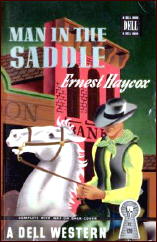
Haycox’s novel is an easy read, even if his prose lacks the punch of Luke Short’s and he really doesn’t invest the action scenes with much energy. He’s very good, though, at conveying the growing tension of an eminent shoot-out, or the suspense of a forthcoming ambush, and in these bits the book really comes alive.
Writer Kenneth Gamet adapted this to the screen, and he managed a few interesting wrinkles while staying close to the book, streamlining the action and bringing some of the minor characters into better focus, particularly John Russell as a socially-challenged outcast, contrasted against Richard Rober as a genial killer.
There’s also an interesting twist at the end as two antagonists resolve their conflict, only to find themselves trapped in their clichéd roles as Good Guy and Bad Guy. In all, an interesting variation on the earlier film, and fun all by itself.
Someone also pointed out another common theme in these films: both Ramrod and this one, they say, carry sexual connotations. Being young and innocent, I wouldn’t know about that, but it’s an interesting thought.
Fri 19 Feb 2010
Posted by Steve under
Reviews[8] Comments
THE BACKWARD REVIEWER
William F. Deeck
PHILIP MacDONALD – The Crime Conductor. Doubleday Crime Club, US, hardcover, 1931. British edition: Collins Crime Club, hc, 1932.
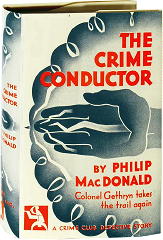
One of the scarccr MacDonalds is The Crime Conductor, if the time it took me to find a copy is any indication. It is also, I feel, the least of all those of his that I have read.
The “Crime Conductor” here is not one who directs crime but to whom crime is attracted — to wit, Anthony Gethryn. Gethryn is joking with his wife’s cousin, a surgeon, about crime occurring around him, and then the surgeon is asked by the police to examine a man who had drowned in his bathtub. Despite the locked bathroom door, the surgeon is suspicious of the death and, naturally, asks Gethryn to take a look.
With some fancy deduction, Gethryn concludes it was murder and explains the locked room in the first third of the book. What he doesn’t explain is why a rich man, not known as a miser, would have lavish private bathing facilities but neither soap nor towels available. The rest of the book is not the typical MacDonald fair play.
Read this one for Gethryn’s letters to his wife, with their delightful self-depreciation.
– From The MYSTERY FANcier, Vol. 13, No. 3, Summer 1992.
Editorial Comment: There are 27 copies offered for sale on Abebooks at the present time, with a reading copy available for only thirteen dollars and change. Even so, I’d have to agree that Bill was correct in terms of its relatively scarcity. There are 179 copies of Warrant for X, for example, just as a quickie comparison. The only softcover edition of The Crime Collector was of British origin; it never appeared in the US in paperback form.
Thu 18 Feb 2010
Posted by Steve under
Authors[2] Comments
More on M. P. SHIEL and “The Yellow Danger”
by JOHN D. SQUIRES.
Regarding this latest discussion on Shiel, there is something to be said for both sides. Jess is clearly right that Asian villains appeared in lots of fiction before 1898 when Shiel got involved.
But, David is also correct in suggesting that The Yellow Danger was something of a breakthrough novel in the genre. It was probably the first yellow peril novel to approach best seller status in England.
I did a lot of research on the yellow peril topic 30 or so years ago for my essay in M. P. Shiel in Diverse Hands (1983), “Some Contemporary Themes in Shiel’s Early Novels: Part I, The Dragon’s Tale: M. P. Shiel on the Emergence of Modern China.”
I read as much as I could find of the pre-1898 YP [Yellow Peril] fiction looking for influences on Shiel and a little of the later stuff looking for examples of Shiel’s possible influences on others.
I concluded that he probably hadn’t read much if any of the prior YP stuff. I can’t speak to the Dime Novels which Jess knows, but the early US stuff originated on the West coast, was largely propaganda against Chinese immigration and may never have been distributed widely in America, let alone England. (For instance, the Woltor title Jess cites was an 82 page pamphlet issued by a California publisher.)
The primary influences on Shiel were contemporary events. The Sino-Japanese War of 1894-95 proved that a “colored” country could master modern weapons and raised the specter of Japan taking over or otherwise leading the untapped masses and resources of China into the modern world.
At the end of the war Russia, Germany and France intervened to force Japan to accept a higher indemnity from China instead of Manchuria and other territories won with blood.
In November 1897 two German missionaries were murdered in China, which provided Germany the pretext to demand control over the port of Kiao-Chau and the neighboring province. France and Russia responded with territorial demands of their own, leading to concerns about the pending break up of China. (Russia actually seized the very territory she had helped to force Japan to give up in 1895.)
England feared the loss of its paramount position in the China trade, as well as the possibility that the concerted actions of Germany, France and Russia might indicate an active alliance among the three against England. There were debates in parliament about the crisis and speculation in the press that war might break out.
Then Peter Keary hired Shiel to write a new serial capitalizing on public interest in the crisis. When the first installment of “The Empress of the Earth” was published in Pearson’s Short Stories on 5 February 1898, his original readers knew the background and recognized the cross-references to recent history and contemporary events.
The first third of the serial literally was incorporating the previous week’s headline events as they occurred, including well-known politicians and other public figures as characters. The public loved it.
And when the Boxer Rebellion broke out in 1899 it seemed to confirm Shiel’s vision of a hostile China declaring war on the West, and triggered a re-serialization of the serial and reissues of the book versions both in England and America.
[There are three major versions of the text. Since it was so popular Pearson instructed Shiel to string the serial out to 150K words, about twice the original contract length. Shiel cut it back by a third for the Grant Richards edition, but had to rewrite the final chapter and make some further revisions to the order of the US publisher. From comments to Richards, Shiel seems to have preferred the Richards text.
[Morse photo-offset the serial with lots of art in Volume I of his series, which is still available. Both the UK & US book versions have been reprinted in expensive series, but are available on Google as pdf downloads.]
And Dr. Yen How, the Sino-Japanese mastermind, was not based on some prior figure from YP literature, or a shadowy criminal from Limehouse (as Rohmer would later claim about Fu Manchu.)
He was almost certainly inspired by the Chinese revolutionary Dr. Sun Yat-Sen (1866-1925,) as I demonstrated in my old essay. (Follow the link.)
Sun had first gained notoriety in 1896 when he was kidnapped and briefly held in the Chinese Embassy in London until screaming headlines roused public pressure on the British government to demand his release. Sun commented: “The reporters drew me into the hotel more forcibly than Tung drew me into the legation building, and they coveted news from me more anxiously than the Manchu government wanted my head.”
Most modern readers who stumble across the book have no idea about any of this, assume Shiel was writing on a clean slate and simply made all that stuff up. Shiel himself considered the novel hackwork and seemed embarrassed about its success. It was the only work published in his lifetime which approached best seller status.
The relative success of Danger as compared to his better work must have galled him. Faced with a steady decline of his income from writing from 1900-1911, he tried to recapture the success of Danger when Sun Yat-Sen came back into the headlines during the Chinese Revolution, culminating in Sun becoming the first president of the new Chinese Republic.
Though it was a better book in most respects, The Dragon (1913, serialized in The Red as “To Arms!”) failed to interest the public and was a complete commercial disaster. Shiel fell into a pit of personal problems and didn’t write another novel for a decade.
Shiel inscribed a copy of The Dragon:
“The fact that God has a predilection for pigtails and microbes (to judge from their number) had always struck me, and there seemed to me such a ‘picture’ in their overflowing with a stare into the west, like the Gadarean pigtails, ‘snout up, tail cocked’; that I was led into writing my second book on one subject — which, I think is not like my way. But ‘the readers’ seemed to prefer the first worst to the second better — pigs as regards tales!– 1924, M. P. Shiel” (Quoted by Morse in
Works Updated, Vol II, p 185.)
Finally, though Jess didn’t mention it, David’s review/essay also has some odd errors about the text of the book itself and other points. John Hardy did not die of consumption. He was killed in a duel. I speculate why in my essay, but I assume few of you are still reading at this point. I could go on, but enough is enough. I’ll stop for now, but there are depths to the book, and Shiel, beyond those suggested in the review.
Thu 18 Feb 2010
REVIEWED BY WALTER ALBERT:
GIVE OUT, SISTERS. Universal, 1942. Patty, Maxine & Laverne Andrews, Grace McDonald, Dan Dailey, Charles Butterworth, Walter Catlett, William Frawley, Edith Barrett, Marie Blake, Fay Helm, Donald O’Connor, Peggy Ryan, The Jivin’ Jacks and Jills. Director: Edward F. Cline. Shown at Cinecon 45, Hollywood CA, September 2009.
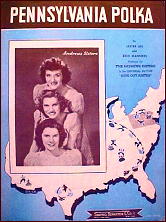
If a stiff drink at dinner didn’t help you recover from the dark byways of Hatter’s Castle (reviewed here ), this sunny musical would certainly have done the job.
The Andrews sisters are the titular stars, but the storyline is fleshed out by an accomplished team of supporting actors, both well known (Butterworth, Catlett, and Frawley) and soon to be known (O’Connor and Ryan, as well as Tommy Rail, a member of the Jivin’ Jacks and Jills).
Butterworth is the owner of a studio where a group of talented young performers is hoping for their big break, which will shortly come at a local nightclub run by William Frawley. The flaw in the plan is that their leader (Grace McDonald) is the ward of three stern aunts (Barrett, Blake and Helm), civic leaders who have no interest in Gracie’s theatrical aspirations.
The brisk pacing with frequent breaks for musical “interludes” keeps things humming until the whole cast (including the three aunts) burns up the screen with a sensational finale, the “Pennsylvania Polka.”
Another of the entertaining, little remembered Universal musicals of the 1940s. If only Turner would program these instead of the MGM classics that we all love but from which we would welcome a break.
« Previous Page — Next Page »

